Volume 13 Number 2
©The Author(s) 2011 Studying the Strawberry Farm: Investigation and Representation in a Standards-based Kindergarten
Abstract
This article documents a first project undertaken by kindergarten children and their teacher in a public school in the southeastern United States. Images, work samples, records of children’s comments, and the teacher’s description tell the story of the project as it unfolds. The authors provide interpretation of the project events documented in terms of situating the Project Approach in a standards-based school context.
School Context
This project was the first undertaken by kindergarten children and their teacher in a public elementary school that serves prekindergarten (Head Start) through fifth-grade students. Seventy percent of the students who attend the school are classified as “economically disadvantaged.” Twenty-five percent are categorized as children with “limited English proficiency.” The school is eligible for participation in state and federal Title I programs.
Topic Selection: Seeing with Fresh Eyes
Charlene Wheeler and the kindergarten children she teaches pass strawberry fields on their way to and from school each day. Their school is located in a town—not far from a larger metropolitan area—widely known for its winter strawberry crops. The Strawberry Festival is an annual event that draws thousands of visitors to the area each year. This particular winter, unseasonably cold weather in the region caused freezing. As a result, the strawberry fields made frequent appearances on the evening news as the community discussed the impact of the water usage required to save the crops.
As Charlene thought about embarking upon a first project with the kindergartners in her class, she was particularly interested in selecting a topic that was relevant to the lives of the children in her classroom, one that had the potential to “help children understand their own experience and environment more fully” and would “strengthen the children’s disposition to look closely at phenomena in their environments worthy of appreciation” (Helm & Katz, 2001, p. 14). Because the strawberries were a part of the community life and many of the children in Charlene’s kindergarten class had family members who worked in the local strawberry industry, she speculated that studying the strawberry farm would help children develop the ability to “defamiliarize” the strawberry fields that they drove past each day and see them with fresh eyes. Defamiliarization involves seeing everyday things in new ways, both connecting to what is known and looking beneath the surface to see with more depth and insight.
Preliminary Planning: A Concern for “Intentionality”
After Charlene selected a topic, she engaged in some preliminary planning. Rather than beginning with thinking about activities that related to the topic, she began by brainstorming all she knew about the topic. This anticipatory planning web (Figure 1) helped her consider the depth of the topic, ponder the possible paths that the project might take, anticipate areas of interest that the children might have, and contemplate ways that she might provoke their thinking about the topic (Helm & Katz, 2001). She also developed a list of possible resources in the community and contacts for fieldwork or classroom visits.
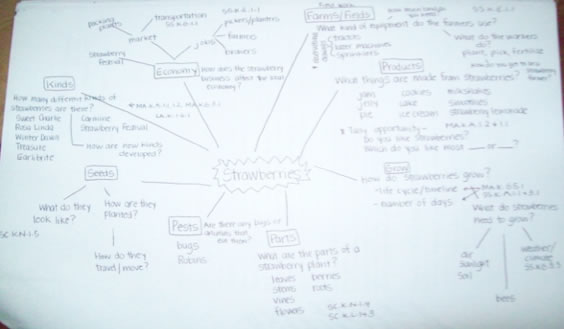 Figure 1. The teacher created an anticipatory planning web.
Figure 1. The teacher created an anticipatory planning web.
In her preliminary planning, Charlene was also very conscious of a standards-based emphasis on the demonstration of acquisition of academic knowledge and skills that was valued at her school and reflective of larger contemporary school discourses. She saw the potential of project work to provide a rich context within which academic knowledge and skills drawn from a variety of domains could be applied meaningfully, and so she was “intentional” (Copple & Bredekamp, 2009) about finding opportunities to embed standards in authentic ways. For example, she studied the standards and looked for opportunities to make relevant connections to them during events that occurred in each phase of the project. Charlene found that she could make connections in multiple ways, including delivering relevant mini-lessons, making suggestions and pointing out connections to make relevant knowledge and skills explicit as the children worked, and intentionally pointing out knowledge and skills applied in planning and debriefing sessions. Often, multiple state standards could be embedded in the project events. The documentation of children’s work provided below illustrates some of the possible connections to state standards.
Phase 1: Finding Common Ground
The central purposes of Phase 1 were to find out what children already knew about the topic in order to connect with and build upon children’s prior knowledge and to generate questions for further research (Katz & Chard, 2000). Because this project was the first for both the teacher and the children, Charlene also wanted to provide the children with some preparatory shared experiences and with opportunities to rehearse investigation skills and processes such as observational drawing, interviewing, and collecting data in preparation for fieldwork. These processes, which are involved in project work, fit well with the state science standards. For example, a “big idea” in the area of the nature and practice of science was that students gain understanding that the process of inquiry involves the formulation of investigable questions, the development of investigations into those questions, the collection of appropriate data, the evaluation of the meaning of those data, and the communication of this evaluation.
Initial Conversations
Charlene provided some shared experiences for the children in order to spark discussions. The children’s initial talk focused on listing things that you could make out of strawberries that are edible. Eating strawberry concoctions was a big part of the annual strawberry festival. With the exception of one child who commented, “When it gets cold, they freeze the strawberries so the strawberries won’t die,” Charlene was surprised to find that there was little discussion about where the strawberries came from and how they grew. She inferred from this that going “behind the scenes” to see the process of growing and harvesting strawberries could be an area worthy of further investigation.
To increase the complexity of the conversations with the children, Charlene provided opportunities for children to observe real objects. For example, she brought a strawberry plant to school and put it at the science observation station (Figure 2). The plant sparked observations and wondering that were recorded on an Observations–Wonderings–Learnings (OWL) chart. During these early conversations, Charlene noted that the children in her class were skillful at posing questions, but she wondered about the children’s ideas about how to investigate to find answers to questions. When she asked the children how they thought they could find out more, they suggested looking in books. Charlene valued the idea of using secondary sources as an important way to gather information and developed a collection of related fiction and nonfiction books to enhance the children’s study. She also realized that the children had little prior experience with firsthand investigative processes and wanted to extend the children’s investigative repertoire. 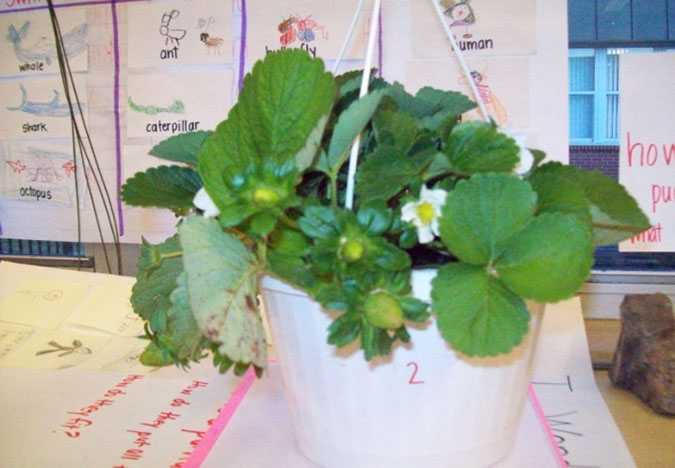 Figure 2. The teacher brought a strawberry plant to school.
Figure 2. The teacher brought a strawberry plant to school.
She asked, “How many of you looked out the window of the bus or their car on the way to school?” All of the children indicated that they had. “Do any of you ever see strawberries on the way to school?” This began a flood of talk about all the farms that they saw. Charlene introduced the term “fieldwork,” and the notion of visiting a strawberry farm to engage in firsthand investigation was greeted with a great deal of enthusiasm.
The value that Charlene placed on fieldwork affected the children’s demeanor and the tone of the discussion. Fieldwork was different from other field trips that the class had experienced. Everyone would have important responsibilities for information gathering and recording. The field notes and artifacts would be brought back to the classroom so they could be revisited. As Phase 1 continued, Charlene intentionally embedded some opportunities to practice investigation processes such as observation, conducting interviews, collecting data, exploring and experimenting with artifacts, and representing findings 2- and 3-dimensionally.
Charlene noted that two kindergarten learning standards were addressed during this initial conversation:
LA.K.4.2.1: The student will participate in creating a variety of informational/expository forms (e.g., labels, lists, graphs, observations, summaries) through drawing or writing.
SC.K.N.1.2: Make observations of the natural world and know that they are descriptors collected using the five senses.
Recording Observations
Charlene explained that one way that the children could find out more about strawberries was by looking very closely and by recording what they saw. To try this out, they drew the strawberry plant in their classroom and went outside to draw the tractor belonging to Mr. Matthew, who was responsible for grounds and maintenance (Figures 3 & 4). Some of the children were able to accurately draw what they saw or to “zoom in” on a small part of the plant or tractor. Others seemed uncertain about where to begin or how to go about such a task. As a result of her observation of the children’s first drawing attempts, Charlene planned to give the children additional opportunities to create “time-2” drawings, and she considered strategies that she might use to facilitate close observation and coach observational drawing processes to increase the complexity with which the children approached drawing.
 Figure 3. Bethany sketched the strawberry plant.
Figure 3. Bethany sketched the strawberry plant.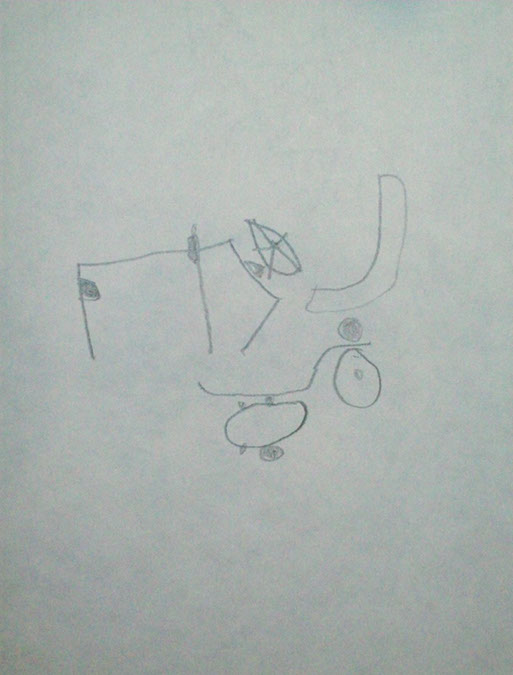 Figure 4. Trey sketched the tractor.
Figure 4. Trey sketched the tractor.
Several kindergarten benchmarks were met during these activities:
SC.K.N.1.4: Observe and create a visual representation of an object which includes its major features.
SC.K.N.1.5: Recognize that learning can come from careful observation.
VA.B.1.1: The student creates and communicates a range of subject matter, symbols, and ideas using knowledge of structures and functions of visual arts.
Three-Dimensional Representation
Another one of Charlene’s aims for this first project was to “provide opportunity for children to develop insight into the functions and limitations of a variety of different media and to develop skillfulness in applying the various media to their work” (Helm & Katz, 2001, p. 14). She talked with children about what it meant to “make thinking visible” so that their ideas could be shared with others. She pointed out some of the ways that they already tried (e.g., observation drawings) and introduced the term “2-dimensional” to describe these representations. Charlene wondered what she could learn about the children’s thinking by challenging them to move from 2-D to 3-D representation.
Charlene invited children to look closely at a strawberry and describe what they saw. Oscar said he saw red, white, and brown seeds. Joseph reported that the color faded toward the top of the berry. Colin pointed out that there were green leaves at the top. To describe the shape, children used descriptive words like round, oval, long, fat, short, and skinny. This discussion provided an opportunity to talk about the difference between 2-D and 3-D shapes (e.g., circle, sphere) and to notice the difference between organic and inorganic shapes. Charlene suggested that clay would be a good medium for representing the 3-dimensional shape of the berry. The children had some experience working with clay in the past, and Charlene offered them some self-hardening clay. The following dialogue was recorded as the children explored the clay:
Joseph: It’s like play dough.
Javier: I used this at my church before.
Joseph: It feels kind of hard.
Blake: I know all about it; I can’t remember what it is called, though, it is cold.
Joseph: So it is a special kind of play dough that is kind of hard and cold.
After some exploration of the clay, the children began using it as a way to represent the strawberries. Charlene encouraged the children to pay particular attention to the shape and texture of their berries. As she watched the children proceed, she noted the various approaches that children took. Some continued to play with the clay, and some started flattening it between their hands or between their hands and the table. Javier found that he could roll the clay into a long, skinny “snake,” or coil, a method frequently used to construct objects with clay. He held his coil up next to his berry and said, “Mrs. Wheeler, this is not the right shape.” He tried folding the coil in half, and when he still was not satisfied with the shape, he laid it on the table and proceeded to smash it with his elbow. Then he announced, “Now it is flat like a pancake, it is not right yet.” Other children were inspired by Javier’s approaches to shaping clay, and they decided to try them out for themselves.
Marley talked to those around her, continuously narrating what she saw and how she tried to work with the clay. Marley spent a lot of time considering how to get her clay berry to match both the overall shape and diameter of the berry she observed. She made multiple attempts, smashing the whole thing and starting over when it did not meet her expectations. She was most concerned about getting the shape right. The berry was somewhat flat and when she created a larger diameter (roundness), the berry she was making lost its overall shape. In the end, she settled for a somewhat flatter version of the berry, but the outline shape of the berry did seem to match the one she was trying to duplicate. In this way, she confronted the challenges presented when attempting to create a 3-dimensional representation as opposed to a 2-dimensional one.
Although many of the children were intrigued with exploring the properties of the clay, Tony took a different approach. He remained very focused on the berry itself. He spent a lot of time looking at it, turning it over and over in his fingers, and then doing a sort of measurement with his fingers—playing with both the diameter and the length. When Tony finally took up the clay, he was very quiet and focused, frequently stopping to compare the clay to his berry. Only when he was satisfied that his clay matched his strawberry did he speak, announcing: “Mrs. Wheeler, I am done.” Tony engaged in very close observation, seeing this ordinary object in a new way.
Another representational challenge emerged when Trevor pointed out that he needed to show the seeds he saw. At first, he tried to remove a tiny seed from his strawberry and push that into the clay. During this activity, the children again observed each other’s work and talked about what they were doing. Alexis agreed with Tony that it was important to represent the seeds. She tried pushing the entire strawberry on to the surface of the clay representation to see if it would leave an imprint. Not satisfied with the result, the children discussed additional possible approaches:
Javier: We can use a pencil to make seeds.
Jordan: No, that will get our clay all black. We can use our fingers.
Joseph: I think we should use a knife.
Blake: That would be deadly.
Joseph: No, a plastic knife.
Jordan: A plastic knife wouldn’t work because we need sharp holes.
Charlene responded by placing some plastic knives and forks on the table (Figure 5). These were taken up by the children immediately. Joseph decided the knife made holes that were too big, and Jordan accidentally sliced his berry in half. Next they tried the fork and found it to be a good tool for creating texture. Some children continued to explore other ways of creating the seeds. Trevor and Javier used their fingernails. Blake came up with yet another method. He took the laminated ABC card from the top of his pencil box and used the corner of it to poke holes in his berry.
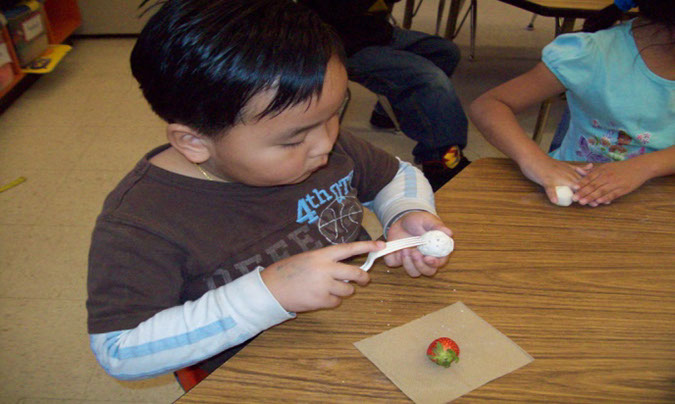 Figure 5. Colin created texture to represent the small seeds.
Figure 5. Colin created texture to represent the small seeds.
The children met kindergarten benchmarks in science, mathematics, and visual arts as they worked on their representations of strawberries:
SC.K.N.1.4: Observe and create a visual representation of an object which includes its major features.
SC.K.P.9.1: Recognize that the shape of materials such as paper and clay can be changed by cutting, tearing, crumpling, smashing, or rolling.
MA.K.G.2.5: Use basic shapes, spatial reasoning, and manipulatives to model objects in the environment and to construct more complex shapes.
VA.A.1.1: The student understands and applies media, techniques, and processes.
VA.B.1.1: The student creates and communicates a range of subject matter, symbols, and ideas using knowledge of structures and functions of visual arts.
Collecting and Exploring Related Artifacts
After a few days of exploring strawberries, children began bringing in project-related artifacts from home. These included strawberry flats and some empty green pint baskets. As Charlene and the children examined the containers and talked about what they were called, an unexpected problem-solving opportunity emerged. Some of the children wondered how the baskets fit in the flat and how many went in each. They hypothesized that the containers had something to do with capacity, or the amount a container could hold. In response, Charlene turned over the flats and pint baskets to the group. After lots of turning and rearranging, they discovered that all of the pint baskets had to be turned a certain way to fit and that the flat was constructed to hold 12 pints (Figure 6).
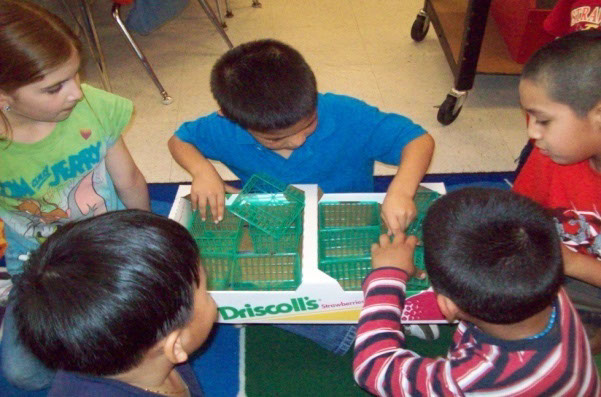 Figure 6. The children determined the number of pint baskets that fit in the flat.
Figure 6. The children determined the number of pint baskets that fit in the flat.
One of the children made a connection between the term used to name the large strawberry container and the “hundreds” piece in the block set that the class used to count the days of school. They were both called “flats.” Did that mean that the box would hold 100 strawberries? When Charlene asked them how they thought they could find out, the children suggested counting. Charlene wondered, “Count what?” They went around the room collecting various manipulatives (blocks, strawberry-shaped erasers, teddy bear counters, etc.) that they thought could be used as “berries.” Although Charlene wondered if variation in the size of berries might affect ways of measuring quantities, the children were more concerned with finding the total number of objects that the container could hold.
In order to keep track of the number of objects, Blake said he thought they should draw around each piece and then count (Figure 7). Jordan said he thought he would write numbers, and Javier said he would make lines like on the calendar board (i.e., tally marks). After an initial effort, Blake concluded that drawing the pictures took too long. He reverted to tally marks after five drawings. Jordan and Javier initially did tally marks but then decided to check their work by writing down the numbers as they recounted (Figures 8 & 9).
 Figure 7. Blake tried drawing “berries” to record capacity.
Figure 7. Blake tried drawing “berries” to record capacity.
 Figure 8. Jordan tallied to keep track of the number of objects it takes to fill the pint basket.
Figure 8. Jordan tallied to keep track of the number of objects it takes to fill the pint basket.
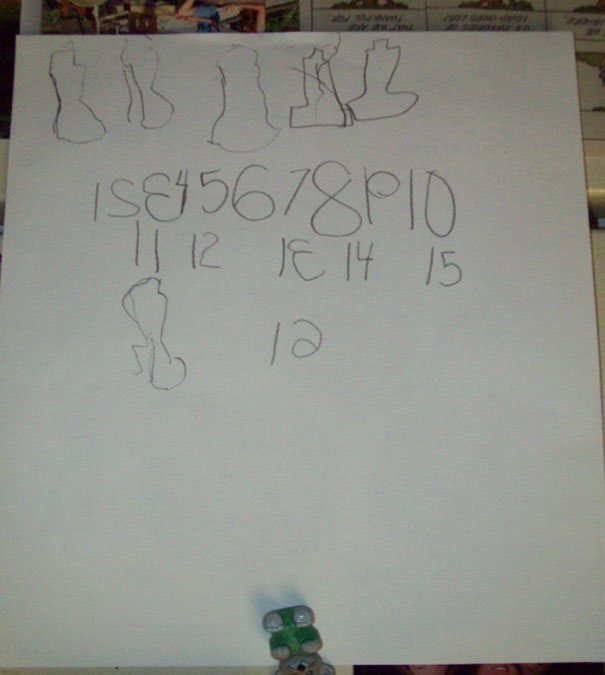 Figure 9. Javier used numerals to record capacity.
Figure 9. Javier used numerals to record capacity.
The children reported their findings to the class at a whole group meeting. Charlene transferred the data from their recording sheets to the large board. As they combined the groups of quantities, they got a total of 338 berry-sized objects. Marley enthusiastically concluded that a strawberry flat would hold way more than 100 because theirs was not even full (they had 4 empty baskets) and they already had 338! In reaching this conclusion, children applied counting skills, recorded quantities, and joined groups to find a sum. This activity also offered the children an opportunity to explore concepts of capacity and volume. The children computed the capacity of the flat by counting the number of objects that could fit in one of the pint containers and joining the groups to find an approximate total volume.
Two kindergarten mathematics benchmarks were met when the children attempted to find the capacity of a strawberry flat:
MA.K.A.1.1: Represent quantities with numbers up to 20, verbally, in writing, and with manipulatives.
MA.K.A.1.2: Solve problems including those involving sets by counting, by using cardinal and ordinal numbers, by comparing, by ordering, and by creating sets up to 20.
Interviewing Visiting Experts
Charlene invited two “strawberry ambassadors” from the local high school’s agriculture department to come and visit the class. These high school students visit local elementary schools and typically provide a short presentation for children during their visit and provide the class with some handouts, related objects (e.g., strawberry-shaped erasers), and a video. Charlene saw this visit as an opportunity to provide a shared experience for the children as they continued to explore what it was they knew and wanted to know. At the same time, she thought that it could provide an opportunity for the children to “rehearse” the interview process, an investigation tool that Charlene wanted them to apply during their first fieldwork experience. Charlene asked the strawberry ambassadors whether they would be willing to respond to children’s interview questions, and they were happy to comply.
The day before the visit, the children prepared for the interview and decided upon who would be responsible for asking which question. Below are a few examples. The visitors’ responses are included after the questions:
Blake: How long does it take to grow a strawberry? 35 days.
Marley: Do strawberries only grow in Florida? No, they also grow in California, Maine, and Nova Scotia. Most farmers get their runners from Maine.
Joseph (deviates from the prepared questions): What are runners? They are like little strawberry plants. The farmer plants them, not seeds.
Jessica: How do strawberries grow? They need sunlight, soil, air, and water.
Joseph: Do they have leaves at the top? Yes. How do they get there? They are around the inside of the flower where the strawberries grow from.
Ben: How many different kinds of strawberries are there? 120.
Blake: Why are the seeds on the outside instead of on the inside? That is just the way it is made. Strawberries are the only fruits where the seeds are on the outside. Farmers don’t plant them. They plant runners.
Marley: Why do a lot of fields have lakes by them? When the temperature drops to freezing and the farmer has to water all night, the water from the sprinklers can go there. It also gives the farmer a way to view the water table.
Trevor: How does the water help the strawberry not get freezed? If the temperature drops below freezing, the juices inside the strawberry will freeze and it will cause the berry to die. The water heats up the temperature and keeps it at 32 degrees. This will insulate the berry.
Jordan: Do they put spray so no bugs will eat them? Yes, but it is safe to people. You should always wash any fruit before you eat it, though.
Jayne: How do strawberries grow on farms? The workers plant all the runners in rows of dirt that are covered in plastic. Then the strawberries need water, sunlight, and air to grow.
In the process of developing and asking questions for the guest expert, children met kindergarten benchmarks in language arts, social science, and science:
LA.K.6.2.1: The student will ask questions and recognize the library media specialist or teacher as an information source.
SS.K.A.1.2: Develop an awareness of a primary source.
SS.K.E.1.1: Describe different kinds of jobs that people do and the tools or equipment used.
SC.K.L.14.2: Recognize that some books and other media portray animals and plants with characteristics and behaviors they do not have in real life.
Webbing
With the teacher’s help, the children created a web of their ideas about strawberries during Phase 1. As children engaged in some shared experiences with the topic, Charlene updated the web to reflect their growing conceptual understanding (Figure 10). To conclude Phase 1, Charlene and the children reviewed what had been accomplished so far and planned for further investigation. The following general questions emerged:
- What is on a strawberry farm?
- How do they grow the strawberries?
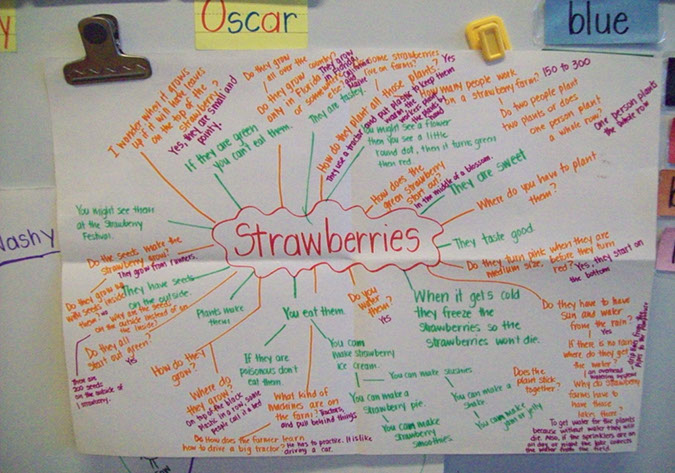 Figure 10. The children’s first web is printed in green. The web was revisited and extended as the project unfolded.
Figure 10. The children’s first web is printed in green. The web was revisited and extended as the project unfolded.
Creating the children’s web met several language arts benchmarks:
LA.K.1.6.3: The student will describe common objects and events in both general and specific language.
LA.K.5.2.5: The student will communicate effectively when relating experiences and retelling stories heard.
LA.K.4.2.1: The student will participate in creating a variety of informational/expository forms (e.g., labels, lists, graphs, observations, summaries) through drawing or writing.
Phase 2: Investigating the Strawberry Farm
The purpose of Phase 2 was to engage in investigation in order to develop answers to the research questions generated in Phase 1. Phase 2 began with a visit to a strawberry farm to engage in firsthand investigation. In preparation for the field trip, Charlene and the children discussed plans for fieldwork. Some children would be responsible for recording the answers to the interview questions that they planned to ask the farmer. The questions, written on individual pages by Charlene, were clipped to their clipboards as reminders. Children would also create observational drawings and count and tally items seen at the farm. Charlene noted that the class as a whole was highly motivated during the preparation and planning for fieldwork.
Visiting the Strawberry Farm
Charlene talked with Mr. Combs, the strawberry farmer, prior to the visit. She shared the children’s questions with him and explained that the children planned to interview him, to create observational drawings of objects on the farm, and to collect some data about the plants. Mr. Combs warmly welcomed the eager kindergartners. After a brief greeting and introduction to the farm, he told them he knew they had questions and invited the children to begin their interview: “Lay them on me.” Blake asked, “How many people work on a strawberry farm?” Mr. Combs replied that it takes between 150 and 300 people, depending on the time of year. Blake tried to represent these numbers with tally marks. Javier deviated from the question that he had prepared. He wondered about the watering system. This was something that had been talked about earlier in the classroom, and Javier transferred and applied his new knowledge from that conversation in the context of the interview.
Charlene compared this interview to the interview with the strawberry ambassadors, and she was surprised by how adeptly the children applied interviewing skills and by the confidence that the children displayed as they posed their questions. She noticed the care that they took to record the responses. She was particularly impressed with deviations from the questions that the children practiced and prepared; this demonstrated their ability to integrate new knowledge and be responsive in a question-and-answer format. The questions and answers recorded in the children’s field notes are listed in Figures 11 and 12.
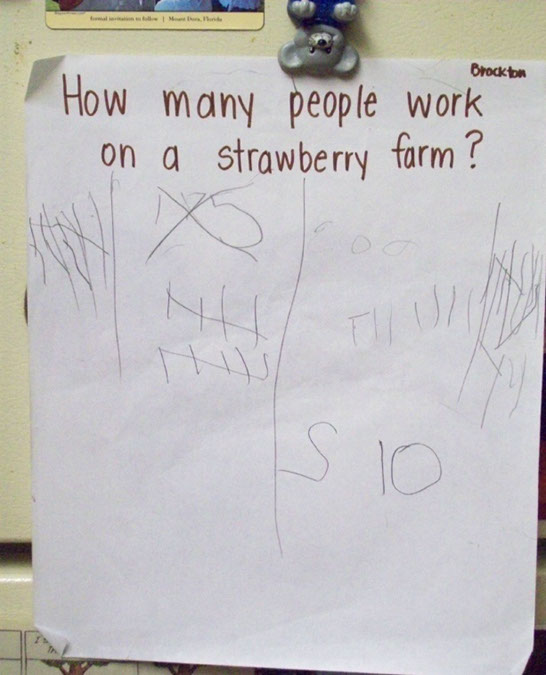 Figure 11. Blake drew a line down the center of the paper to differentiate the two numbers. He recorded the first number: “150.”
Figure 11. Blake drew a line down the center of the paper to differentiate the two numbers. He recorded the first number: “150.”
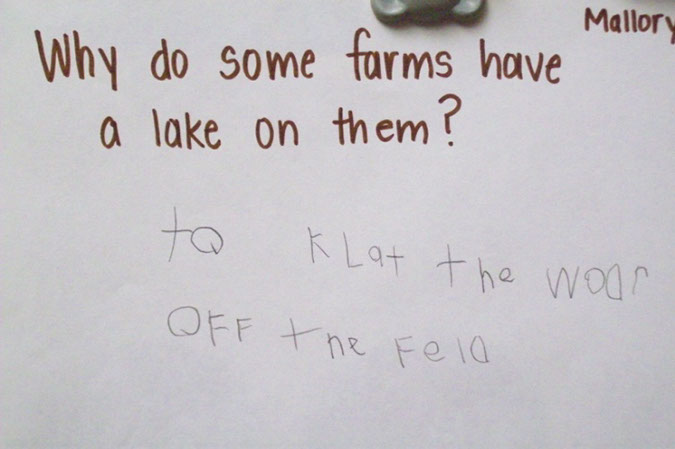 Figure 12. The children recorded an answer: “To collect the water off the field.”
Figure 12. The children recorded an answer: “To collect the water off the field.”
Next Mr. Combs showed the children how to pick a strawberry, what to look for, and how to remove the strawberry from the stem (Figures 13 & 14). He and Blake demonstrated, and then he gave each child a quart container and let them try picking the berries. He gave them permission to eat as many as they wanted to along the way. Because the berries had been watered extensively the night before, the strawberries were nice and clean and tasted delicious! Although the children’s excitement was palpable, Charlene noticed that there also seemed to be a sense of importance within the group about being invited into Mr. Comb’s strawberry field. This shared experience became a valued memory and a story that the children told about during their kindergarten year.
 Figure 13. Mr. Combs demonstrated how to pick berries.
Figure 13. Mr. Combs demonstrated how to pick berries.
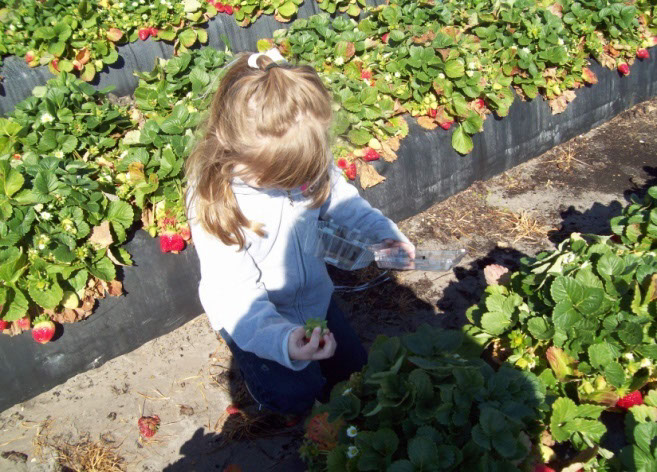 Figure 14. Sarah examined a berry.
Figure 14. Sarah examined a berry.
After everyone had eaten their fill of berries and filled their containers, the children settled in to begin additional fieldwork (Figures 15-29). Family members who accompanied the class had been briefed ahead of time about what was expected of the children and were there to help as needed. The children had a data-recording chart to collect data regarding plants, blossoms, green strawberries, and red strawberries in a row. They also had blank sheets of paper attached to their clipboards for observational drawing and other note taking.
Charlene met with a small group of boys. After they had settled in and started doing some observational drawings, she planned to circulate and check in on other groups. She was concerned about leaving this group. Experience told her that some 5-year-olds might not stay on task without adult support. She was amazed when she returned and found all three on their knees in the middle of the row, pencils in hand, engrossed in their observations and drawings. She captured the scene in photographs below. Charlene considers the boys’ engagement a highlight of this first project. 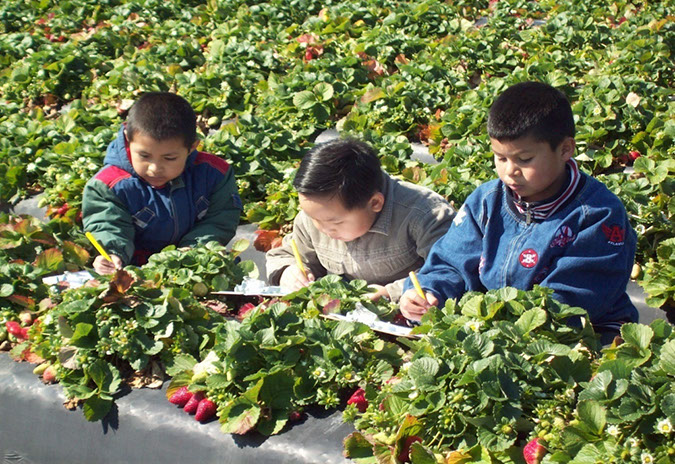 Figure 15. Three boys worked independently. They were deeply engaged in careful observational drawing.
Figure 15. Three boys worked independently. They were deeply engaged in careful observational drawing.
 Figure 16. Javier and Tony focused on a part of the row that has a sprinkler and valve cover.
Figure 16. Javier and Tony focused on a part of the row that has a sprinkler and valve cover.
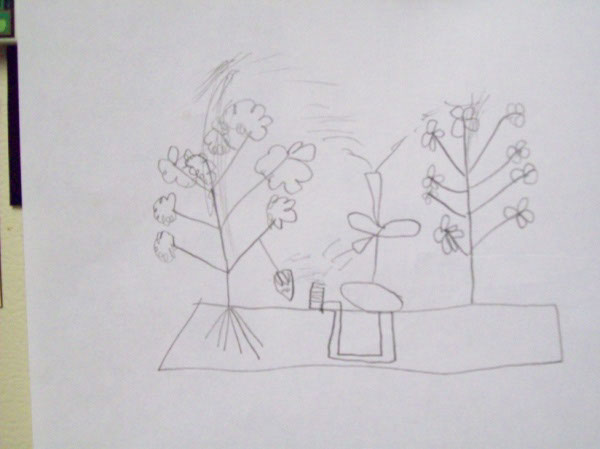 Figure 17. Javier drew the row: “This is the row, the plants, and the watering system.”
Figure 17. Javier drew the row: “This is the row, the plants, and the watering system.”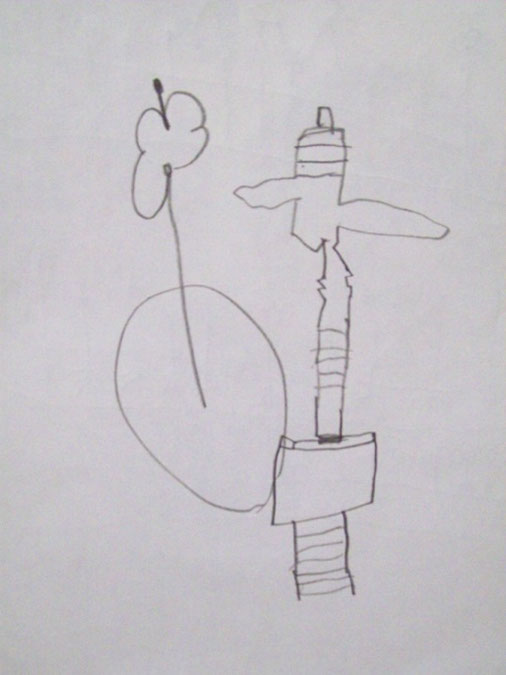 Figure 18. Tony drew the sprinkler and the valve that he observed inside the valve cover.
Figure 18. Tony drew the sprinkler and the valve that he observed inside the valve cover.
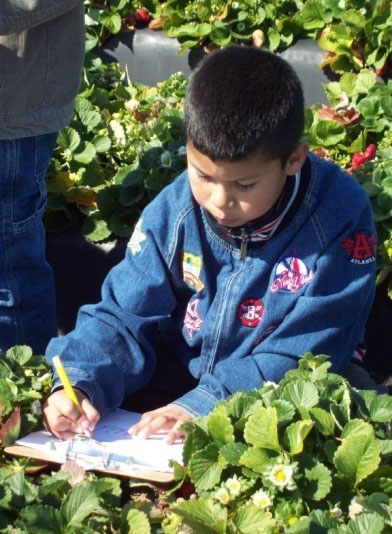 Figure 19. Tony concentrated on the row as a whole.
Figure 19. Tony concentrated on the row as a whole.
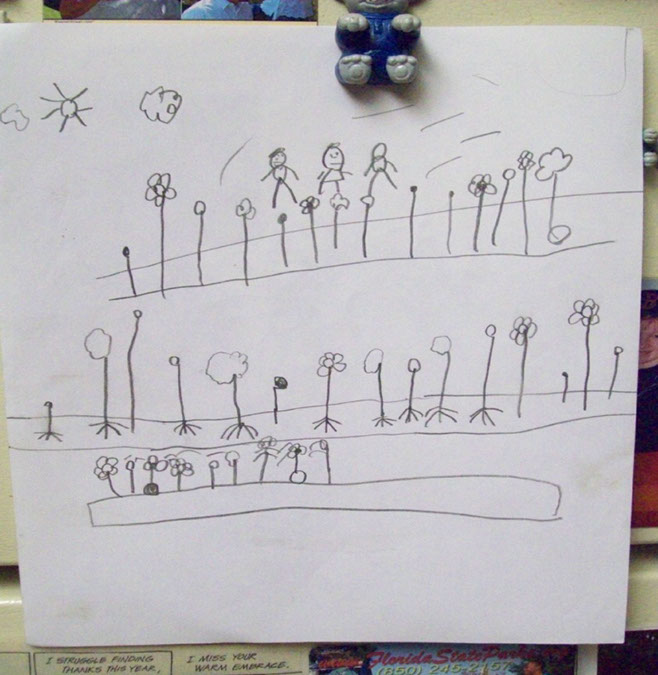 Figure 20. Tony’s drawing was of the “rows, with plants and flowers and strawberries and us here too.”
Figure 20. Tony’s drawing was of the “rows, with plants and flowers and strawberries and us here too.”
 Figure 21. Colin observed the sprinkler closely: “I think there’s something in there.”
Figure 21. Colin observed the sprinkler closely: “I think there’s something in there.”
 Figure 22. Colin’s observational drawing was of the sprinkler.
Figure 22. Colin’s observational drawing was of the sprinkler.
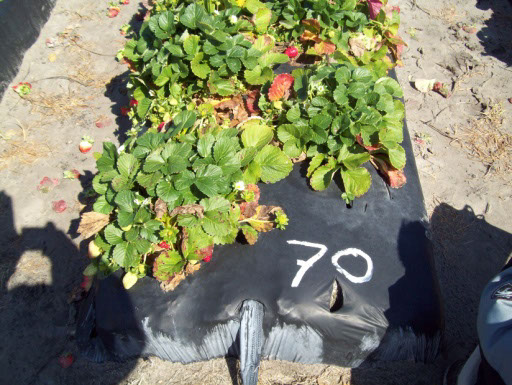 Figure 23. Colin observed the number 70 on the end of the row and the pipe for the drip line. He theorized that the number told the farmer what row it was so he wouldn’t get lost in the fields.
Figure 23. Colin observed the number 70 on the end of the row and the pipe for the drip line. He theorized that the number told the farmer what row it was so he wouldn’t get lost in the fields.
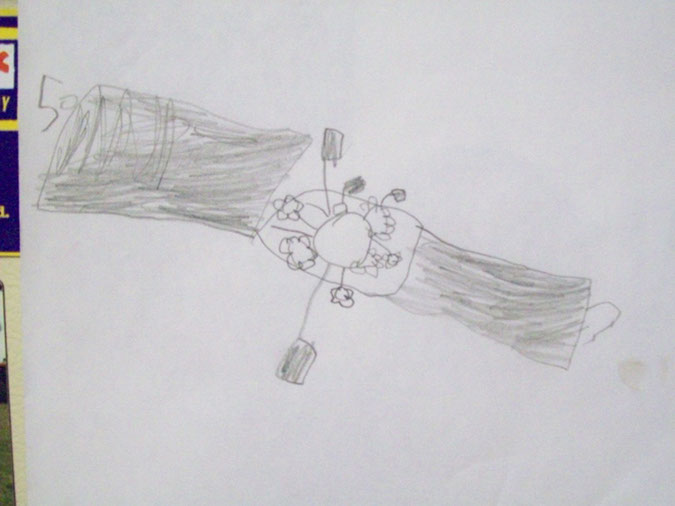 Figure 24. Trevor explained, “I’m drawing the black. It is shielding the strawberry.”
Figure 24. Trevor explained, “I’m drawing the black. It is shielding the strawberry.”
 Figure 25. Jayne intently observed the blossoms on the plant.
Figure 25. Jayne intently observed the blossoms on the plant.
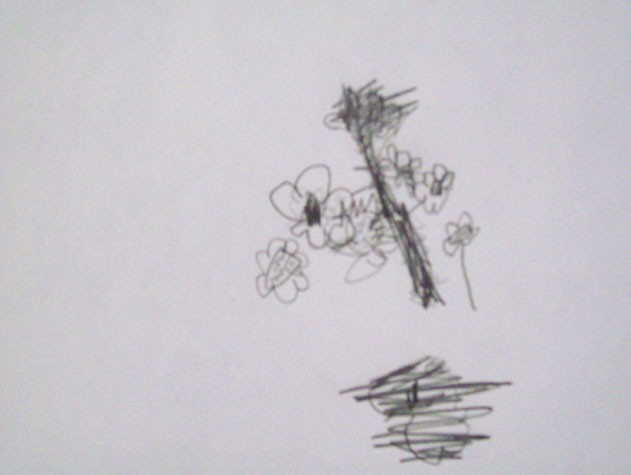 Figure 26. The blossoms were prominently featured in Jayne’s observational drawing.
Figure 26. The blossoms were prominently featured in Jayne’s observational drawing.
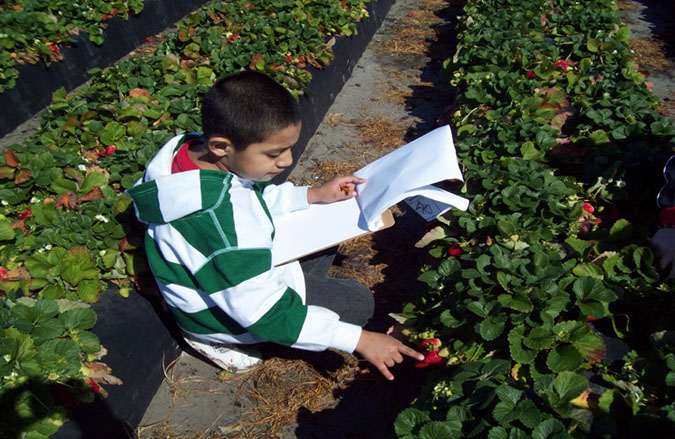 Figure 27. Diego focused on the strawberries.
Figure 27. Diego focused on the strawberries.
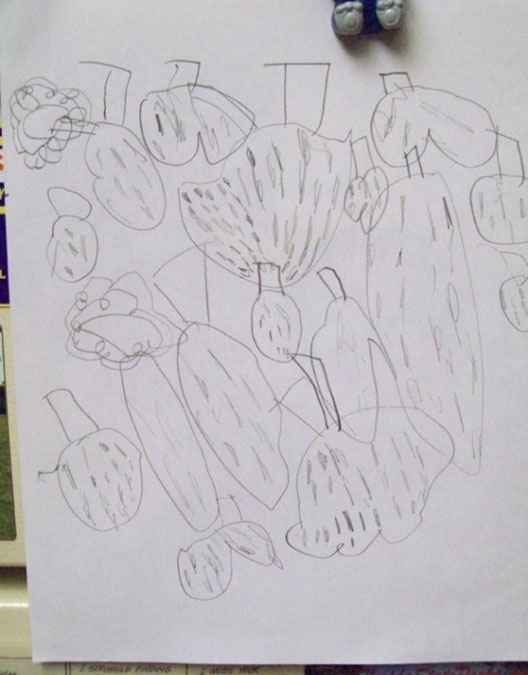 Figure 28. Diego’s observational drawing was of the strawberries.
Figure 28. Diego’s observational drawing was of the strawberries.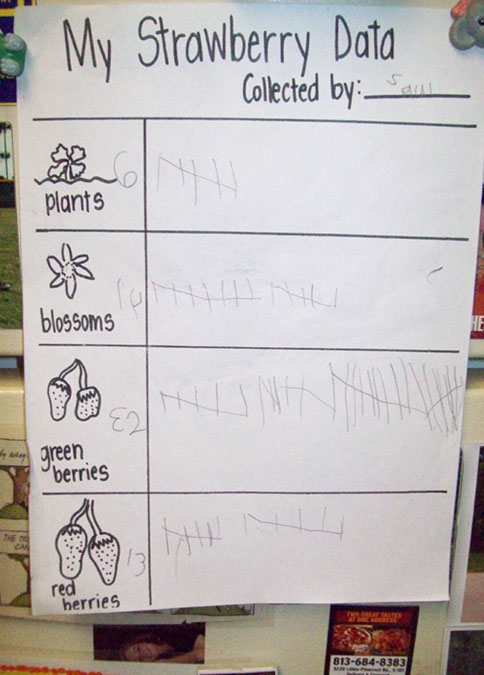 Figure 29. Diego recorded strawberry data on a prepared form.
Figure 29. Diego recorded strawberry data on a prepared form.
Charlene noted that the visit to the strawberry farm enabled the children to meet a number of kindergarten benchmarks in language arts, science, math, and social studies:
LA.K.4.2.1: The student will participate in creating a variety of informational/expository forms (e.g., labels, lists, graphs, observations, summaries) through drawing or writing.
LA.K.6.2.1: The student will ask questions and recognize the library media specialist or teacher as an information source.
LA.K.1.1.4: The student will match print to speech.
SC.K.N.1.4: Observe and create a visual representation of an object which includes its major features.
SC.K.N.1.3: Keep records as appropriate—such as pictorial records—of investigations conducted.
SC.K.N.1.5: Recognize that learning can come from careful observation.
MA.K.A.1.1: Represent quantities with numbers up to 20, verbally, in writing, and with manipulatives.
SS.K.E.1.1: Describe different kinds of jobs that people do and the tools or equipment used.
SS.K.A.1.2: Develop an awareness of a primary source.
Debriefing and Planning
After Charlene and the children returned to the classroom, they gathered together for a class meeting. Charlene asked the children to share something about the visit that they thought others who hadn’t visited the farm should know. In their responses, the children talked about what they saw on the farm and what they found out about strawberries and how they grow. Charlene acted as recorder, writing the main ideas down on paper (Figure 30).
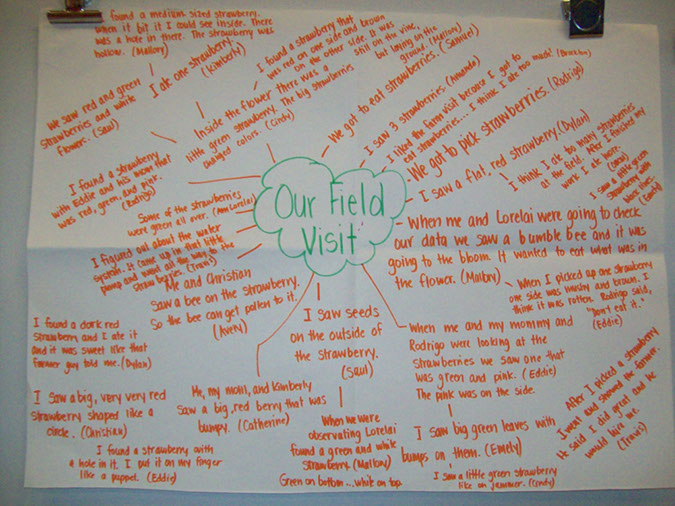 Figure 30. Charlene made a record of the discussion of important findings from the field visit.
Figure 30. Charlene made a record of the discussion of important findings from the field visit.
The next day, Charlene and the children viewed the photographs from the field visit and looked at their field drawings and notes. Charlene wondered with children how they could represent what they had learned. They came up with a plan to construct a model of the strawberry farm. Together they brainstormed a list of all of the things they would need to include in the model (Figure 31).
 Figure 31. Children make a list during the process of planning to construct the model. “We need: name-sign, sprinkler, baskets, black plastic, drip line, plants, berries, runners, cart, rows (beds), black plastic hole, pump house, tractor, lake.”
Figure 31. Children make a list during the process of planning to construct the model. “We need: name-sign, sprinkler, baskets, black plastic, drip line, plants, berries, runners, cart, rows (beds), black plastic hole, pump house, tractor, lake.”
As they talked, they realized that creating the model would be a challenging endeavor. Charlene and the children agreed to manage the task by creating focus groups, and they decided that each would work on one of the following parts that the children identified as important—the rows, the lake, the plants, the tractor, the sprinkler system, the pump house, and the cart. As she thought about her role in facilitating the work, Charlene wondered whether the children would lose interest and want to switch groups, as sometimes happened during choice times in the past. Although she anticipated possible responses to this issue, she did not need to implement them. All of the children chose to remain in their focus groups and saw their tasks through to completion. Charlene was impressed by the task commitment that the children displayed; she also noticed that sometimes toward the end of the project work period, a child or a few children would choose to consult with another group that needed additional help.
Each day, the project work time began with a planning meeting. Focus group members would update the class on their progress and report any problems that they might have been having. If someone had an idea for a strategy to address the problem, they shared it with the group. Each group articulated a plan for the day, and then off they went to work.
During the debriefing and planning process, the children met several language arts benchmarks:
LA.K.5.2.5: The student will communicate effectively when relating experiences and retelling stories heard.
LA.K.4.2.1: The student will participate in creating a variety of informational/expository forms (e.g., labels, lists, graphs, observations, summaries) through drawing or writing.
LA.K.6.2.3: The student will participate in creating a simple class report where the teacher is the scribe.
Constructing the Strawberry Farm
Actually getting started required even more detailed planning that involved considering the overall goal and outlining the steps that would need to be taken to reach the goal. For example, children in the lake focus group and the group working on rows realized that they needed to consult with each other that first day in order to talk about the placement of the lake and the rows on the model.They referred to photos of the field, the lake, and the pump house, considering the locations of each in relation to one another in order to create a map. After that, they returned to their two smaller groups.
The small group of children responsible for the rows had an initial discussion:
Emilio: The beds are made out of dirt.
Trevor: They are not beds. They are called rows.
Emilio: Mrs. Wheeler said we can call them beds or rows. My daddy says they are beds, and he works there.
Trevor: OK.
Caroline: We do not have any dirt in here.
Emilio: I guess we can’t make any rows.
Charlene asked them what else they knew about the rows. The children remembered that they had black plastic on the outside of them. As the discussion unfolded, the children considered materials that could be used to represent, or symbolize, the rows. They could fill black plastic garbage bags with something to represent the dirt that filled the plastic at the farm. Newspaper was available, and this seemed to the children to be a viable packing material. The children began crumpling the paper and filling the bags. Then they taped the bags together and made a drip line with black paper tape that they glued blue yarn to. They also made a pipe for the drip line at the end of the row with a paper tube and numbered the rows as was done at the farm (Figures 32-36).
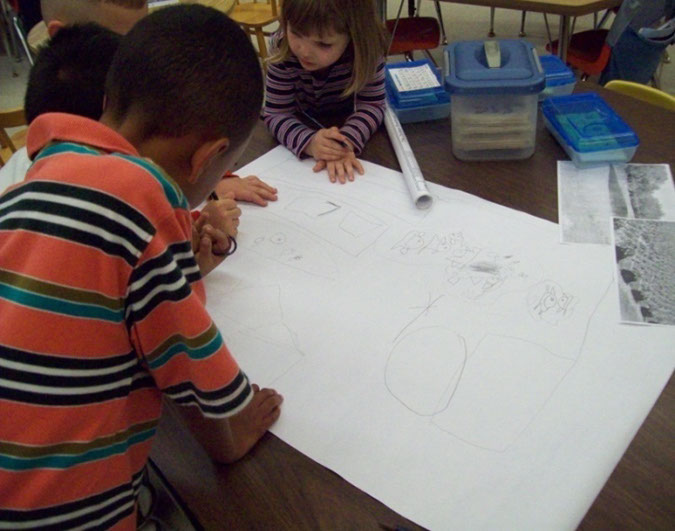 Figure 32. The lake and rows groups consulted, collaborating to create a map of the whole farm in order to understand the relationship between the areas they had identified.
Figure 32. The lake and rows groups consulted, collaborating to create a map of the whole farm in order to understand the relationship between the areas they had identified.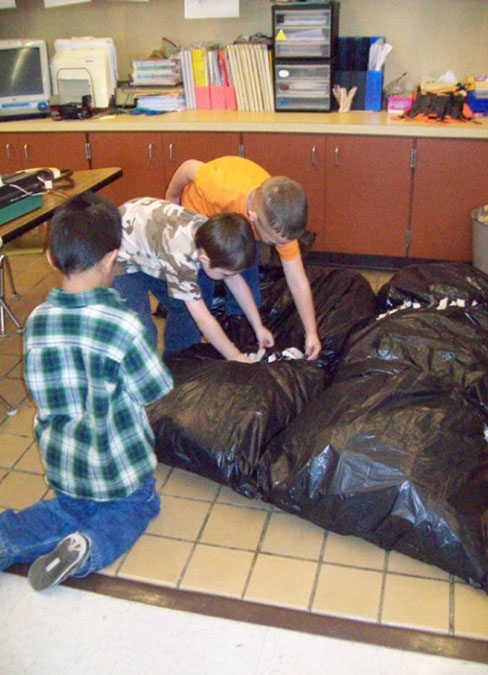 Figure 33. The rows group worked to place the rows parallel to one another.
Figure 33. The rows group worked to place the rows parallel to one another. Figure 34. Emilio made the numbers to label the rows. He counted by “10” and used 2-digit numbers.
Figure 34. Emilio made the numbers to label the rows. He counted by “10” and used 2-digit numbers.
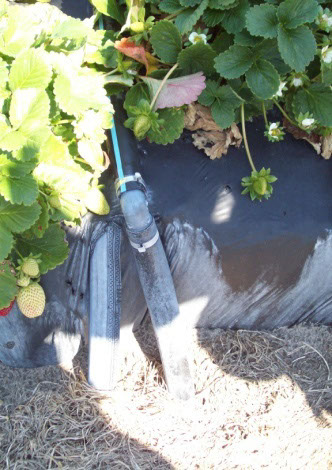 Figure 35. Photographs taken at the farm were frequently referenced.
Figure 35. Photographs taken at the farm were frequently referenced.
 Figure 36. The end of the row makes the close attention to accurate detail evident; it is numbered and includes the drip line and pipe to connect the drip line to the watering system.
Figure 36. The end of the row makes the close attention to accurate detail evident; it is numbered and includes the drip line and pipe to connect the drip line to the watering system.
Meanwhile, the lake construction group began with large pieces of blue and green paper (Figures 37-39). The first problem that they reported to the group was that they could not get the grass to stand up on the edge of the lake. They attempted placing the paper in various ways using glue. The children also noted, "Some didn’t stand up because they were too big.” Later they reported that when they reduced the size of the grass, they got it to stand up. When they finished with the grass at the edge of the lake, they decided to make trees like those in the photograph of the lake. In a subsequent meeting, they shared a “tree problem.” They said, “We can’t get the leaves to stand up on our trees, they are all flat.” Charlene wondered if the strategy they tried to get the grass to stand up would work for the trees. Later that same day, she heard a loud, ”We got it!” and Joseph and Diego announced that they had figured it out: “You have to put glue on the side so they can be up and not down.”
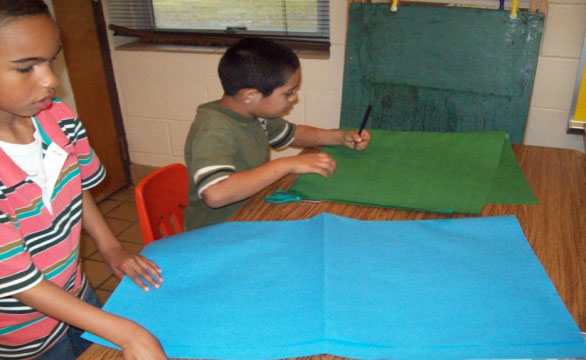 Figure 37. The children began construction of the lake.
Figure 37. The children began construction of the lake.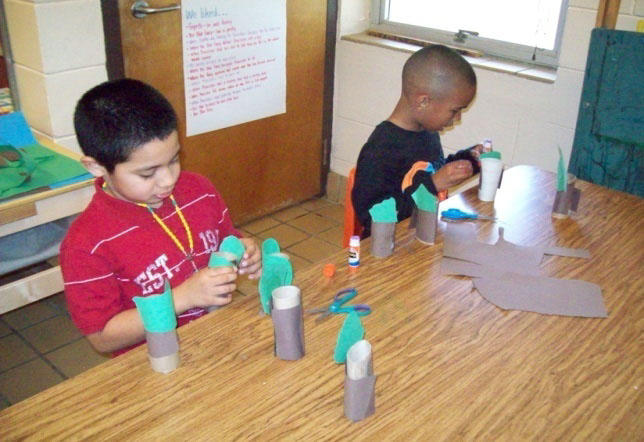 Figure 38. Joseph and Diego addressed the problem of making the leaves “stand up.”
Figure 38. Joseph and Diego addressed the problem of making the leaves “stand up.”
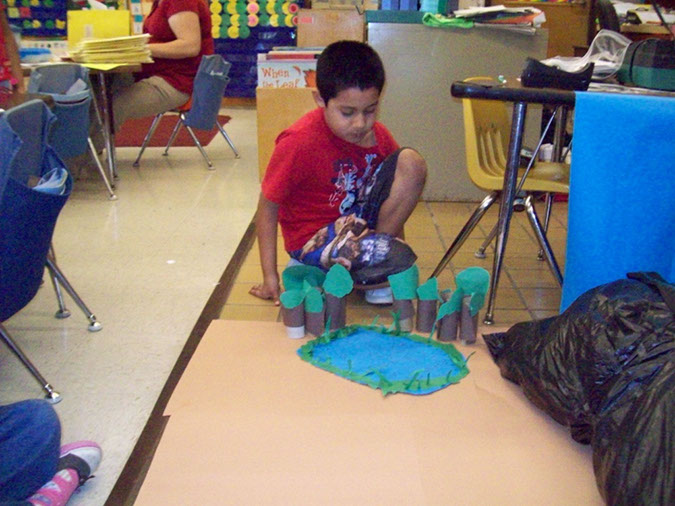 Figure 39. A child looks over the completed lake and trees.
Figure 39. A child looks over the completed lake and trees.
Jayne and Bethany were responsible for the pump house (Figure 40). They began by selecting some Popsicle sticks and an empty, white milk bottle to use for constructing the model. When Charlene asked about their reasoning for selecting these materials, they pointed to a water storage tank that was beside the pump house in the photograph. The bottle would be used to represent the pump. They also pointed to the “lines” (boards) going down the sides of the building and on the roof. They planned to use the Popsicle sticks to represent the boards.
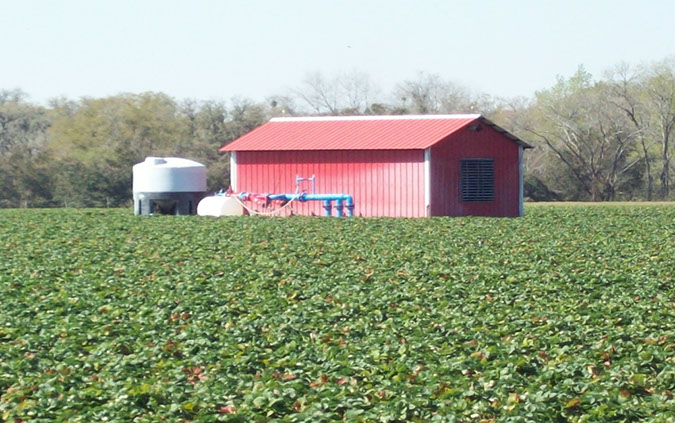 Figure 40. Children had observed the pump house at the farm.
Figure 40. Children had observed the pump house at the farm.
Although they agreed about the selection of materials, they disagreed about how to use them. Bethany tried putting the Popsicle sticks in a line on the floor in order to create two squares. Jayne suggested to Bethany that this was not how they looked in the photograph. Charlene asked her to explain, and Jayne used her hands to show the vertical positioning of the boards in the image. “They are not like this,” she said as she rested one flat on the ground.
Charlene asked how they thought they could make the Popsicle sticks stand vertically. Jayne went and got a whole cereal box and a leftover piece from one of the other groups. She told Bethany that the whole box could be the house and the piece could be the top. Bethany listened to Jayne’s argument and agreed that it made good sense. They started gluing the sticks to the roof piece. When Charlene checked back in later, they had retrieved a piece of cardboard to use as backing so they could glue the sticks (Figures 41 & 42). When she asked about it, they said the glue kept getting on their fingers when they tried to hold it and put the glue on so they devised this more effective way to glue.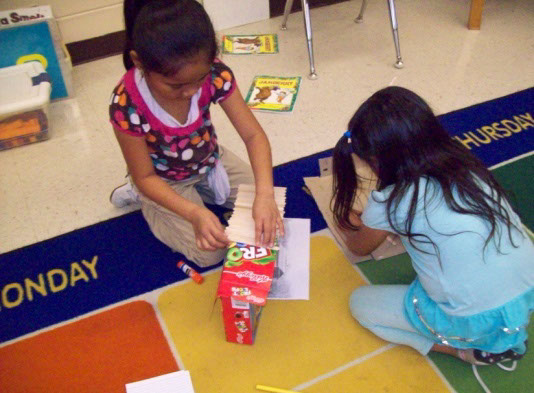 Figure 41. The girls used a support structure to address the problem of vertical alignment.
Figure 41. The girls used a support structure to address the problem of vertical alignment.
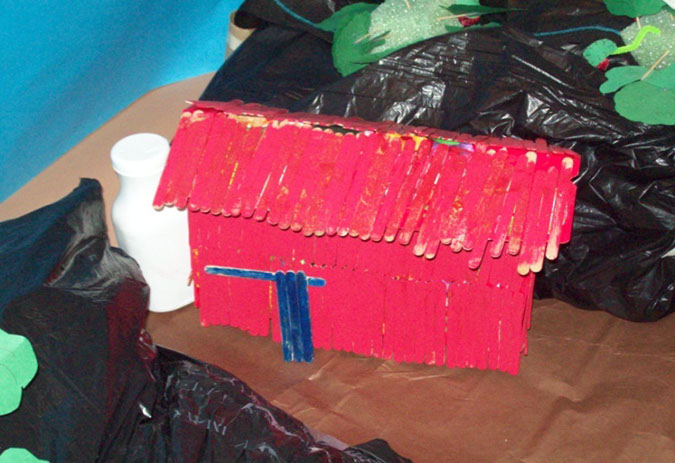 Figure 42. The children completed the pump house model.
Figure 42. The children completed the pump house model.
Another small group was responsible for representing the strawberry plants that the children had seen at the farm. They began by creating 3-D representations of strawberries using the clay that they had practiced with earlier. After the clay dried, they carefully painted the berries, using shades of green and red to indicate the various stages of ripeness. They used a fine-tipped black marker to add the seeds. The next step was to create the leaves and stems with green construction paper and pipe cleaners. They added “lines for the water” on the leaves and decided to use Styrofoam to create the plant itself. Marley informed the group, “My grandma uses this stuff at her house. It holds the flowers so they don’t fall. It can hold the strawberries.” They poked the stems into the Styrofoam and taped the leaves to toothpicks and inserted them. Their final step was to add some blossoms. They used yellow stems to differentiate the blossoms, “‘cause when they first grow they are yellow” (Figures 43 & 44).
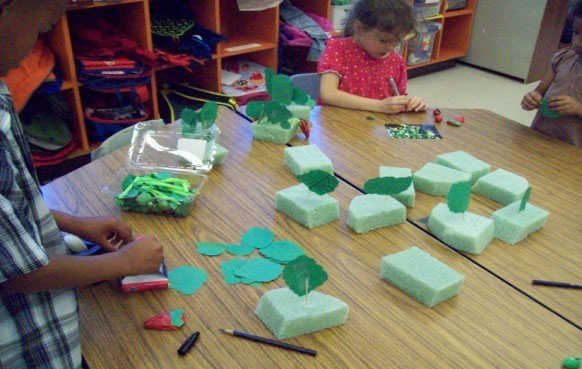 Figure 43. Clay, Styrofoam, and paper were used to construct the 3-D strawberry plant.
Figure 43. Clay, Styrofoam, and paper were used to construct the 3-D strawberry plant.
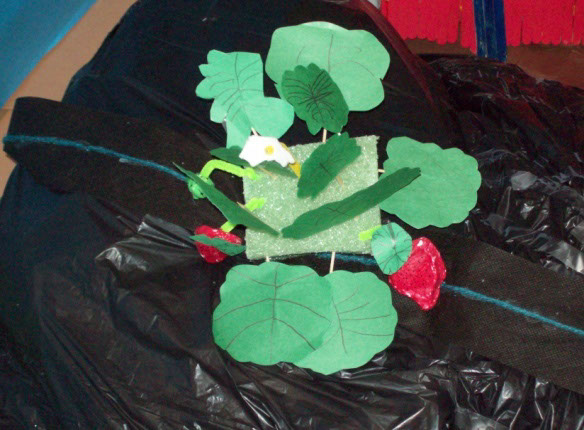 Figure 44. Completed models included stems, leaves with veins, berries, and blossoms.
Figure 44. Completed models included stems, leaves with veins, berries, and blossoms.
Jordan and Colin were responsible for the tractor (Figures 45-47). At first, they seemed to go and get any materials that caught their eye and then quickly discard them. Charlene observed that they did not reference the photograph of the object or appear to have a plan for the materials. She decided not to intervene immediately. As she watched, the boys began to work with more focus. Jordan began cutting an egg carton in small pieces, and Colin began gluing Popsicle sticks on a Styrofoam plate. When Charlene checked with them later, she asked them to talk about their plans. Jordan responded he did not know, and Colin said he was making a steering wheel. Reflecting upon this first session, Charlene wondered whether they had needed more assistance to address the challenge of representing the tractor or if perhaps they had not been invested in this particular work and if she should have helped them consider alternatives.
The next day when she met with the two boys, they had created a giant smoke stack out of an empty hand sanitizer bottle and two paper tubes. They still did not seem to be able to articulate a plan for representing the tractor itself. Charlene asked them what they thought they could use to make the chassis, and they chose one side of leftover cardboard from a cereal box. They turned it over and over, and they finally decided that they could put two wheels on the bottom. They glued on a large Styrofoam plate and a small, plastic fruit bowl on the front. They also glued on some Popsicle sticks for some of the pieces that they had seen on the tractor. At the end of that day’s work, they realized that this “flat” tractor was not going to stand up on its own.
A breakthrough occurred the next morning when Colin entered the classroom and said, “I was thinking of using a box when it was night time.” He and Jordan chose a shoebox and asked if they could paint it so that it would be ready for project time. This seemed to be a turning point. From here, they revisited the photograph as a reference and began purposefully looking for materials that would help them revise their construction. They included a smokestack, seat, wheels, and steering wheel. They completed their tractor by writing the word “International” on both sides. First, Colin held the picture and read the letters one at a time to Jordan so that he could write them, and then they switched places and Colin wrote on the other side while Jordan read the letters to him.
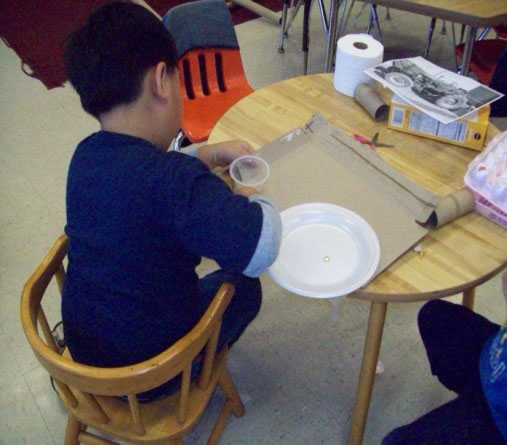 Figure 45. Children began work on the tractor.
Figure 45. Children began work on the tractor.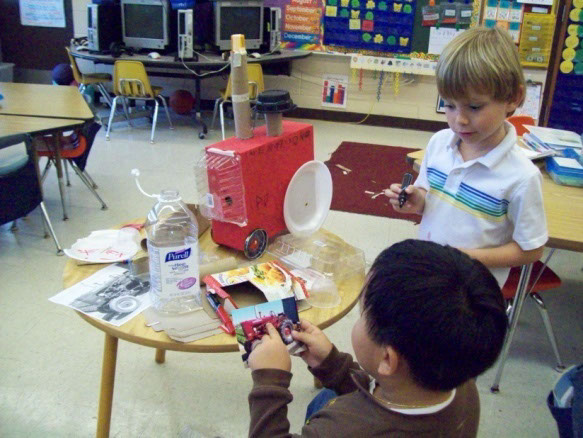 Figure 46. After devising a plan for revising their 2-D representation to a 3-D one, the boys identified a list of items to include on the model.
Figure 46. After devising a plan for revising their 2-D representation to a 3-D one, the boys identified a list of items to include on the model.
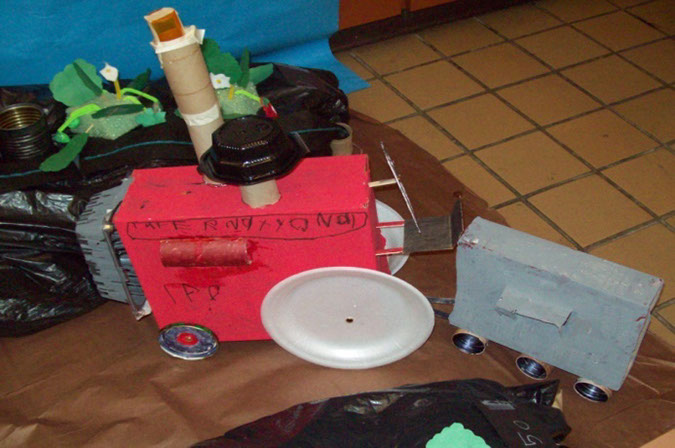 Figure 47. The completed tractor included smaller wheels in front and large wheels in back, the smoke stack, the front grill, a seat and steering wheel for the farmer, and the word “International” printed on the side, as it was on the actual tractor.
Figure 47. The completed tractor included smaller wheels in front and large wheels in back, the smoke stack, the front grill, a seat and steering wheel for the farmer, and the word “International” printed on the side, as it was on the actual tractor.
Blake contributed the sprinkler and the valve cover to the model of the farm. Initially, there was a dispute about a paper tube that he felt was critical to the design but that had already been selected by another child. To begin to think about possible solutions, Charlene encouraged Blake to revisit the field photos and notes. After studying the field records, he decided that a Styrofoam plate would be better suited for the valve cover. Then, after taking another look at the supply table, he chose a plunger/dispenser from an empty hand sanitizer bottle and decided that he would turn that into the sprinkler. He took black paper and cut two pieces and taped them on to the top of the plunger.
The next day, Blake realized that the valve cover should have been red, but there were no red plates available in the supply area. Then it occurred to him that he could color his plate red, and he did so with a red marker. He and Charlene took another look at the photograph and saw that the sprinkler had some other parts. He chose an empty, white film canister and asked Charlene to make a hole in the bottom so that he could slide it over the tube part of the plunger. Then he noticed that there was a gray washer in between the white piece and the sprinkler and set about to make his own “washer” with self-hardening clay. Last, he decided that he needed a new piece for the inside of the black tube. He said he knew that inside the tube there was the valve to turn the water on to the sprinkler. He chose to make it with self-hardening clay (Figures 48 & 49).
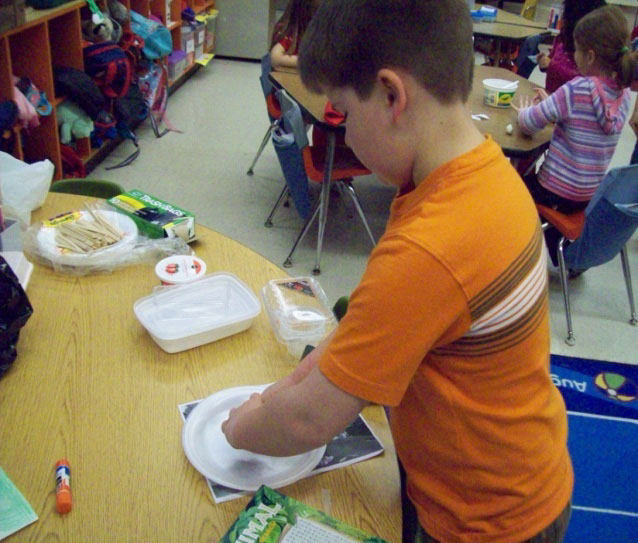 Figure 48. Blake thought about what parts he wanted to represent and what materials and media he could use.
Figure 48. Blake thought about what parts he wanted to represent and what materials and media he could use.
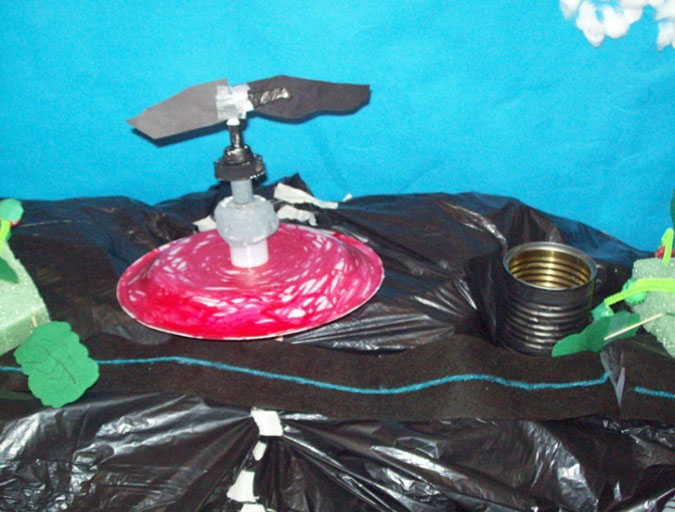 Figure 49. Children completed a sprinkler and valve cover. An aerial view of the sprinkler model shows the valve for turning the water on and off.
Figure 49. Children completed a sprinkler and valve cover. An aerial view of the sprinkler model shows the valve for turning the water on and off.
Javier and Tony worked to construct the cart that they had seen at the farm (Figure 50). They began by looking closely at a photograph of the cart taken at the farm. After a while, Javier announced he knew what they needed. He went to the supply area and selected paper tubes of various lengths. He found a roll of masking tape that he thought would make a good wheel for the cart. After selecting and gathering needed materials, the boys started by making an axle to hold their wheel. They took a short tube and placed it through the center of the masking tape wheel and began addressing the problem of how to attach two longer tubes to both ends of the axle in order to create the frame of the cart. Tony offered some transparent tape, and they taped the two ends on.
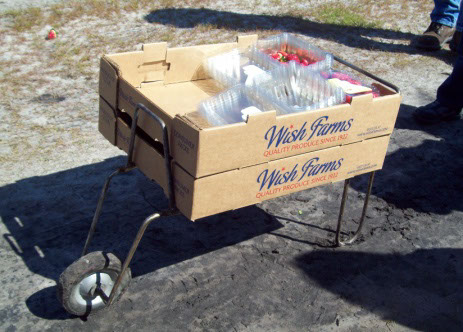 Figure 50. The children had observed this cart in use at the farm.
Figure 50. The children had observed this cart in use at the farm.
Next, Javier set up a long tube vertically. They set out trying to figure out a way to attach the long tube to the tube holding the wheel in order to make the cart 3-dimensional. They tried very long pieces of transparent tape, but the tube wouldn’t stand, so they switched to clear packing tape. They managed to attach one side of the axle to the long tube, but the vertical tube was no longer standing up. Making the frame of the cart required both of them—one to hold the tube and one to tape (Figures 51 & 52).
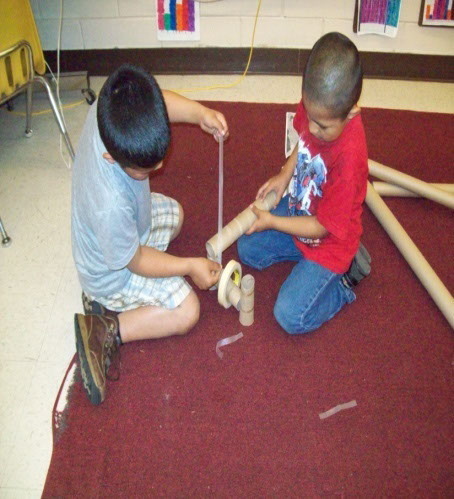 Figure 51. The boys made an initial attempt to create an axle for the front wheel.
Figure 51. The boys made an initial attempt to create an axle for the front wheel.
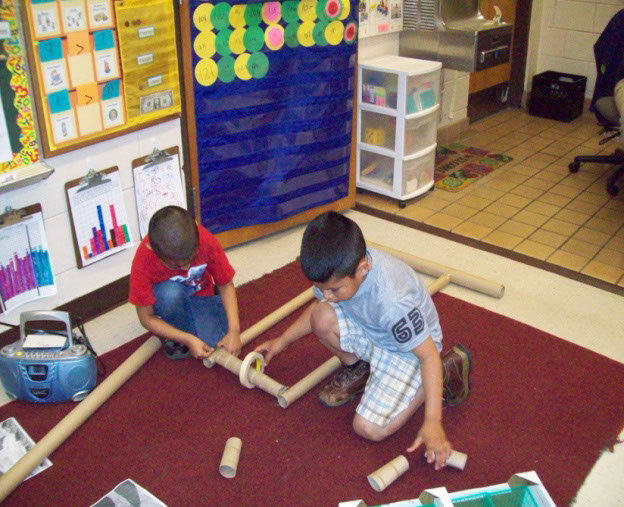 Figure 52. The boys realized that they needed a longer axle.
Figure 52. The boys realized that they needed a longer axle.
They began working on adding a long tube to the end opposite the wheel, and Javier held it up to position it as a handle for the cart. He tested to see if they could roll it. This test was successful, so they attached the handle and replaced the short tube axle with a longer tube. Javier explained that the longer tube was better because it wasn’t so hard to attach the tubes that formed the frame perpendicular to the axle. Next they placed one of the flats across another paper tube that they had taped across the frame. They said they needed it to hold the flat because it kept falling off without the support. At that point, they stood back. They had finished creating the wheel, attaching the frame of the cart, and creating a support to hold the flat. They were satisfied with the results and declared the model “done.”
The next day when they revisited the model, they realized that their construction did not have legs to support it evenly as the actual cart did (Figure 53).
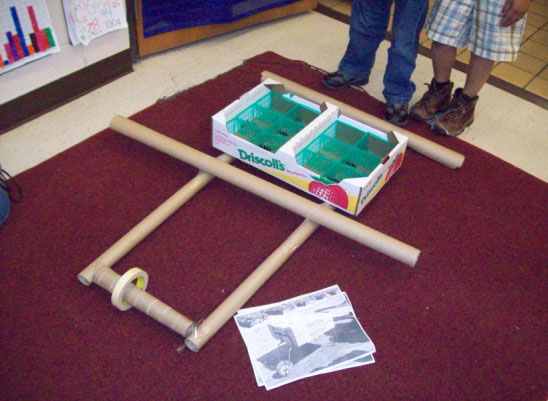 Figure 53. The children decided that this first “draft” of the cart needed to be revised.
Figure 53. The children decided that this first “draft” of the cart needed to be revised.
They got busy making the legs out of more tubes and then were faced with the problem of how to attach them to the cart. They used packing tape until they ran out, then requested glue to finish. They added two small handles to the underside of the cart. The children faced another dilemma when they realized that they had inverted the cart when they added the legs. What had been on the top was now on the bottom, and so they no longer had access to the piece that held the flat in place. There was a period of concern when they realized that they had run out of long tubes. They quickly devised a strategy to solve this problem. They could tape several smaller tubes together to make one longer one (Figures 54-56).
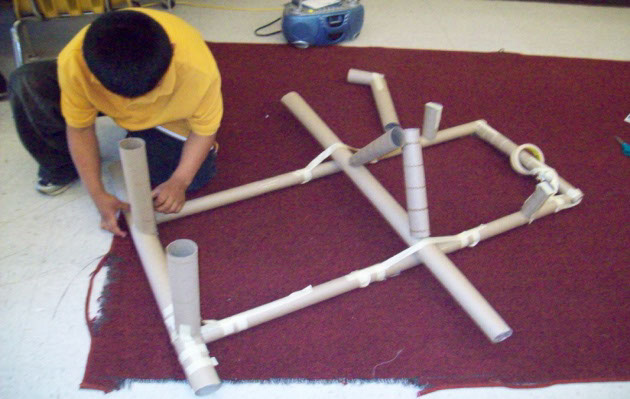 Figure 54. They started adding the legs to balance the cart.
Figure 54. They started adding the legs to balance the cart.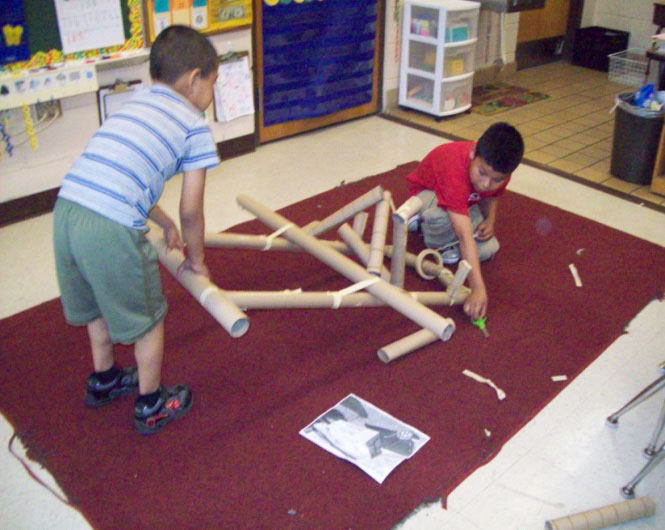 Figure 55. The boys encounter another problem. When they added the legs for stabilization, they inverted the frame of the cart.
Figure 55. The boys encounter another problem. When they added the legs for stabilization, they inverted the frame of the cart.
 Figure 56. The children were satisfied with this final version. It stood on its own, could be moved using the front wheel, and held a flat of berries.
Figure 56. The children were satisfied with this final version. It stood on its own, could be moved using the front wheel, and held a flat of berries.
Charlene noted that as they worked on their 3-dimensional representations, the children met a number of kindergarten benchmarks in language arts, mathematics, science, and social studies:
LA.K.1.6.1: The student will use new vocabulary that is introduced and taught directly.
LA.K.1.6.5: The student will use language correctly to express spatial and temporal relationships (e.g., up/down, before/after).
MA.K.G.2.5: Use basic shapes, spatial reasoning, and manipulatives to model objects in the environment and to construct more complex shapes.
MA.K.A.4.1: Identify and duplicate simple number and non-numeric repeating and growing patterns.
MA.K.G.3.1: Compare and order objects indirectly or directly using measurable attributes such as length, height, and weight.
SC.K.N.1.4: Observe and create a visual representation of an object which includes its major features.
SC.K.P.9.1: Recognize that the shape of materials such as paper and clay can be changed by cutting, tearing, crumpling, smashing, or rolling.
SS.K.A.1.2: Develop an awareness of a primary source.
SS.K.E.1.1: Describe different kinds of jobs that people do and the tools or equipment used.
SS.K.C.2.3: Describe fair ways for groups to make decisions.
SS.K.G.1.1: Describe the relative location of people, places, and things by using positional words.
Revisiting Observational Drawings
The children revisited the observational drawings that they had completed earlier in the project. Now that they had more experience with the topic and had engaged in fieldwork, their “time-2” drawings illustrated growth in observation skills and in conceptual understanding (Figures 57-60).
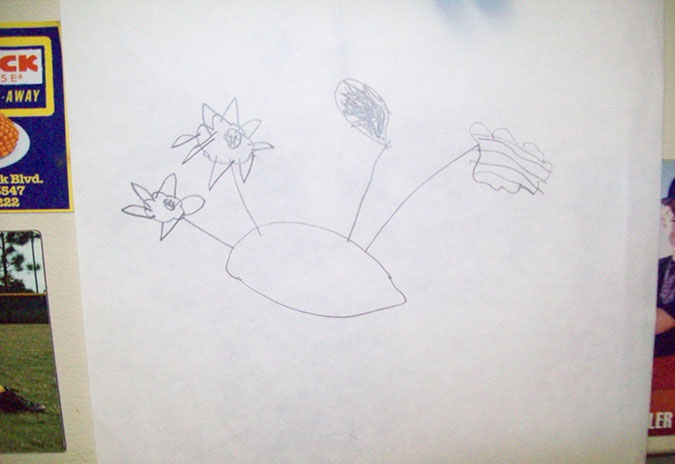 Figure 57. Bethany’s time-1 drawing is basic.
Figure 57. Bethany’s time-1 drawing is basic.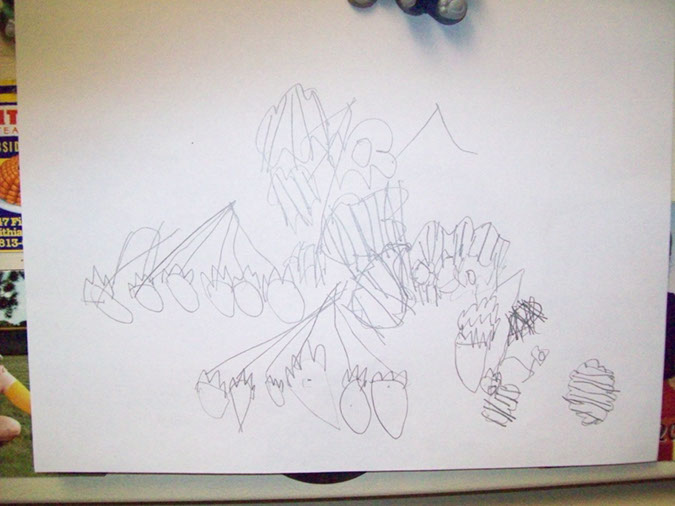 Figure 58. Bethany’s time-2 drawing shows more detail.
Figure 58. Bethany’s time-2 drawing shows more detail.
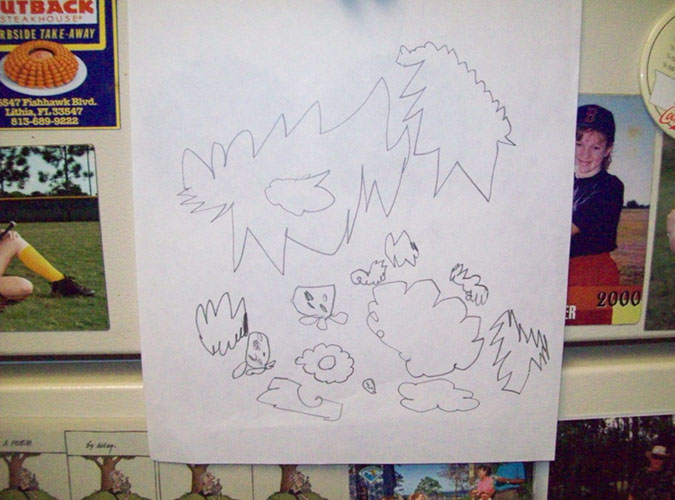 Figure 59. Diego drew outlines of many objects in his time-1 drawing.
Figure 59. Diego drew outlines of many objects in his time-1 drawing.
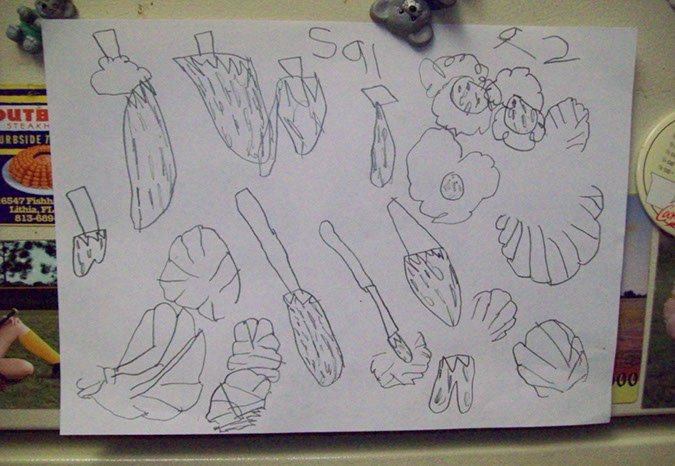 Figure 60. His time-2 drawing shows details of the objects.
Figure 60. His time-2 drawing shows details of the objects.
The time-1 and time-2 drawings suggest that the children met benchmarks in science and language arts:
SC.K.N.1.4: Observe and create a visual representation of an object which includes its major features.
LA.K.4.2.1: The student will participate in creating a variety of informational/expository forms (e.g., labels, lists, graphs, observations, summaries) through drawing or writing.
Interpreting the Data
The children also revisited the data that they had collected at the farm. They reviewed their own individual data sheets and compared quantities most and least. Then they compared data sheets in order to look for trends. They noticed that each data sheet indicated that green strawberries were most common (Figure 61). The children theorized about what the implications of this were for the farm. Joseph said that because the green berries would be ripening soon, it would be important to prepare to pick them quickly. They connected this to their classroom strawberry plant observations. One of the strawberries had become overripe and rotted on the vine. Additional verification was provided by an informational text available in the classroom library—ripe strawberries can only stay on the vine for three days before rotting. Marley inferred that this explained the large number of people who worked on the farm and why the number increased at certain times of the year: “With all those plants, the berries would rot if they didn’t get picked on time.”
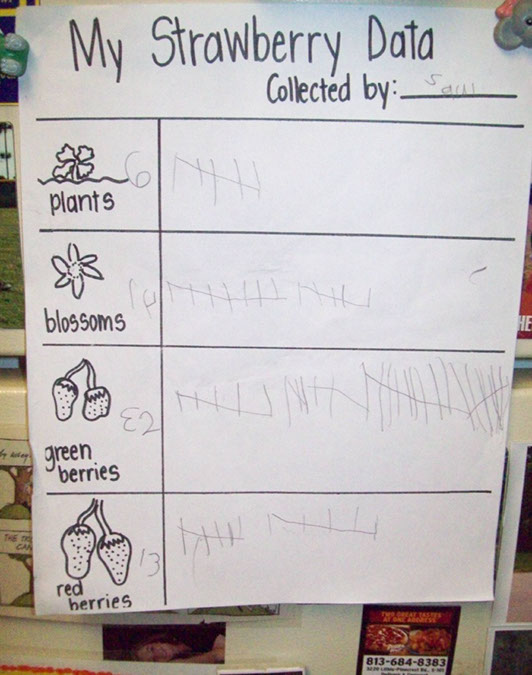 Figure 61. This data sheet represents the larger trend in the growing stages: Green berries were most frequent during the time of the visit to the strawberry farm.
Figure 61. This data sheet represents the larger trend in the growing stages: Green berries were most frequent during the time of the visit to the strawberry farm.
Phase 3: Culminating and Sharing
The purpose of Phase 3 is to review and evaluate what had been learned and for the children to communicate what they had learned. During Phase 3, Charlene and the children revisited the general questions they posed in Phase 1: What is on a strawberry farm? How do they grow the strawberries?
Individual Reports
Charlene and the children added to the initial topic web created during Phase 1, and the children created individual summative reports about what they had learned (Figures 62-64).

Figure 62. Bethany’s rendering of the farm included a numbered row with the black plastic covering, strawberries, a drip line, the runners, a sprinkler, a tractor, a tree, a pump house, and a lake.
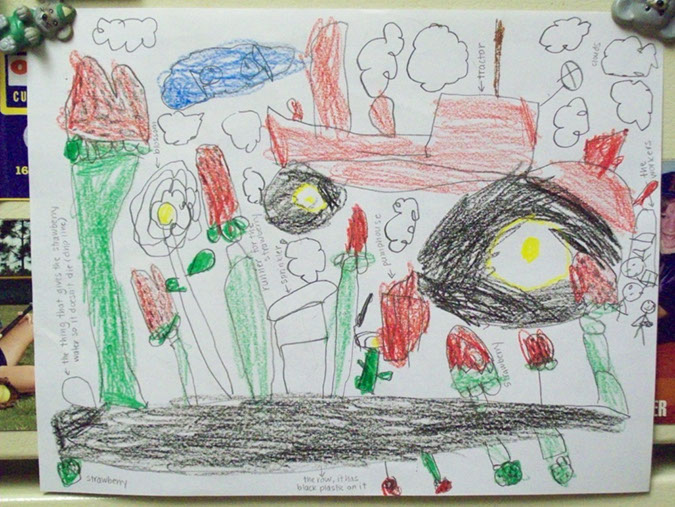 Figure 63. Diego drew the runners for the strawberries (the green objects). He also included the strawberries, blossoms, sprinkler, drip line, pump house, tractor, the row (“it has black plastic on it”), workers, the lake, and clouds.
Figure 63. Diego drew the runners for the strawberries (the green objects). He also included the strawberries, blossoms, sprinkler, drip line, pump house, tractor, the row (“it has black plastic on it”), workers, the lake, and clouds.
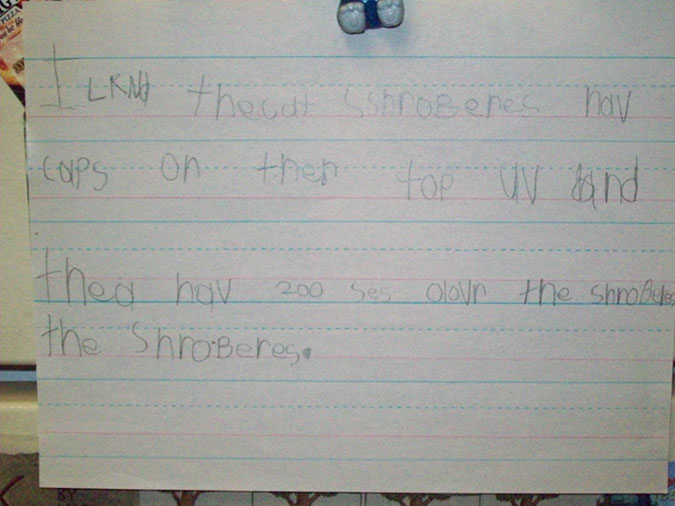 Figure 64. Javier wrote: “I learned that strawberries have caps on their top and they have 200 seeds all over the strawberries, the strawberries.”
Figure 64. Javier wrote: “I learned that strawberries have caps on their top and they have 200 seeds all over the strawberries, the strawberries.”
Charlene observed that the children met a number of language arts benchmarks during the process of revisiting their questions:
LA.K.1.1.2: The student will distinguish letters from words.
LA.K.1.1.4: The student will match print to speech.
LA.K.1.1.6: The student will move top to bottom and left to right on the printed page.
LA.K.4.1.1: The student will create narratives by drawing, dictating, and/or using emergent writing.
LA.K.4.2.1: The student will participate in creating a variety of informational/expository forms (e.g., labels, lists, graphs, observations, summaries) through drawing or writing.
LA.K.5.2.5: The student will communicate effectively when relating experiences and retelling stories heard.
Presenting to Others
In order to summarize what was learned during the investigation and communicate the key ideas to others, the children planned to present their work to others. Mr. Combs, the strawberry farmer they visited, was invited in turn to visit the classroom. The children had arranged all of the parts of the model together to make a whole that represented the relationship of the items on the farm (Figure 65). As the children explained the work to him, Mr. Combs pointed out the things that he noticed (Figure 66).
 Figure 65. The completed model of the strawberry farm was displayed in the classroom.
Figure 65. The completed model of the strawberry farm was displayed in the classroom.
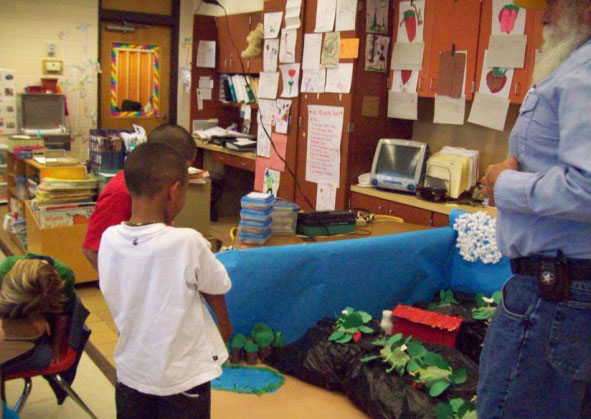 Figure 66. The children presented the model to Mr. Combs. “At first we couldn’t get the grass to stand up because the pieces were too big.” The children also shared what they had learned with a fifth-grade class (Figure 67). First, they took the video of their presentation to Mr. Combs and viewed it with the fifth-grade classroom. The video was followed by a Q & A session during which the fifth-graders asked the kindergartners questions. The discussion continued back in the kindergarten classroom, where the fifth-graders could look at the model of the farm and see the children’s field notes and photographs.
Figure 66. The children presented the model to Mr. Combs. “At first we couldn’t get the grass to stand up because the pieces were too big.” The children also shared what they had learned with a fifth-grade class (Figure 67). First, they took the video of their presentation to Mr. Combs and viewed it with the fifth-grade classroom. The video was followed by a Q & A session during which the fifth-graders asked the kindergartners questions. The discussion continued back in the kindergarten classroom, where the fifth-graders could look at the model of the farm and see the children’s field notes and photographs.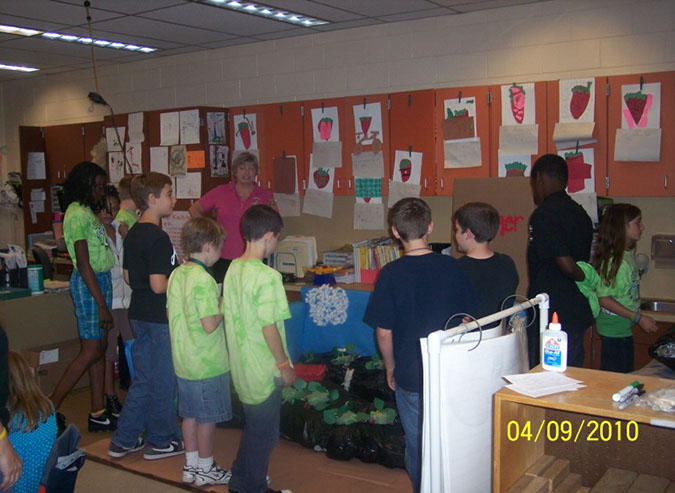 Figure 67. The children presented the model of the farm to fifth-graders.
Figure 67. The children presented the model of the farm to fifth-graders.
As they shared what they had learned with Mr. Combs and the fifth-grade class, the children met benchmarks in language arts and social studies:
LA.K.1.6.1: The student will use new vocabulary that is introduced and taught directly.
LA.K.5.2.5: The student will communicate effectively when relating experiences and retelling stories heard.
SS.K.A.3.1: Use words and phrases related to chronology and time to explain how things change and to sequentially order events that have occurred in school.
SS.K.G.2.1: Locate and describe places in the school and community.
Reflections on a First Project
Teachers of young children often report experiencing tension as they strive to implement developmentally appropriate practices within school contexts that emphasize standards-based and test-driven instruction. This first project in a kindergarten classroom tells the story of how one teacher embedded state-mandated knowledge and skills within the meaningful context of an in-depth investigation of the strawberry farm.
While Charlene took an active role in the investigation, she was also highly sensitive to opportunities for listening to children and negotiating the project work. In reflecting upon the nature of her role in this first project, Charlene noted the importance of her awareness and understanding of the state standards. She also stressed the value of introducing investigation skills to the children and giving them time to practice those skills.
As illustrated in the project documentation, many of the state standards were addressed through project work. Standards are broad expressions of values. Charlene found that embedding standards effectively required pondering what the standards meant and what addressing them might look like; that is, it involved thinking about what kinds of experiences would offer the opportunity for children to “show” their understanding of the concepts and skills embodied in the standards. Project work did not replace systematic direct instruction in Charlene’s classroom; rather, it was complementary and enhanced direct instruction by providing an authentic context within which to apply knowledge and skills. Charlene found that project work allowed for differentiation of instruction, and there were many times when she observed the expectations delineated in the standards exceeded.
Because this was the children’s first project, Charlene also took into account that children had never engaged in investigative fieldwork in this way. Making a distinction between lack of experience and lack of capability or readiness, Charlene expected that as children’s opportunities to engage in project work increased, the children would demonstrate increasingly sophisticated investigation and representation skills. She intentionally introduced processes such as observation, interviewing, and data collection and framed opportunities for children to rehearse these skills prior to engaging in fieldwork.
In addition to the knowledge and skills delineated in the standards, the children learned that the process of inquiry involves the formulation of investigable questions, planning ways to find out answers to the questions, and communicating what was learned. They explored a variety of ways to represent thinking (e.g., speaking, drawing, writing, 3-D modeling). They learned to look more closely at their environment, gained a sense of what happens behind the scenes, and gained a stronger understanding and appreciation of the world around them. The project strengthened the children’s dispositions to persist at a task over time, make revisions to improve work, seek solutions when encountering problems, collaborate with others, and to take risks and try new things. This first project engaged the minds of the children and the teacher in this kindergarten classroom. As Charlene reflected on the experience as a whole, she explained what she took away from this first project:
Through this project, I have learned that project work empowers children because they are in charge of the direction of their learning…they have a voice in what comes next. Additionally, a real sense of purpose becomes very evident, as well as the ownership and pride the children assume for not only their part of the project, but for the entire project as a whole. The experience has changed the way I look at my role as a teacher. I now see myself more as the facilitator (helper) of their self-initiated growth rather than the one who disseminates all the knowledge or information. Learning comes alive with project work, and I believe that is the best gift we can give to ourselves, our children, and to each other.
References
Copple, Carol, & Bredekamp, Sue (Eds.). (2009). Developmentally appropriate practice in early childhood programs serving children from birth through age 8. Washington, DC: National Association for the Education of Young Children.
Helm, Judy Harris, & Katz, Lilian G. (2001). Young investigators: The project approach in the early years. New York: Teachers College Press.
Katz, Lilian G., & Chard, Sylvia C. (2000). Engaging children’s minds: The project approach (2nd ed.). Stamford, CT: Ablex.
Author Information
Charlene Wheeler is a kindergarten teacher and an early childhood education graduate student at the University of South Florida, where she was introduced to the Project Approach.
Charlene Wheeler
University of South Florida
Early Childhood Education Graduate Program
4202 E. Fowler Avenue
Tampa, FL 33606
Email: wheelerc1@mail.usf.edu
Jolyn Blank is an assistant professor of early childhood education in the Department of Childhood Education and Literacy Studies at the University of South Florida. Her research focuses on art and inquiry in early schooling and on early childhood teacher learning. She has published in journals such as Teaching and Teacher Education, Journal of Early Childhood Teacher Education, Early Childhood Education Journal, and Young Exceptional Children.
Jolyn Blank
University of South Florida
Department of Childhood Education & Literacy Studies
4202 E. Fowler Avenue
Tampa, FL 33606
Telephone: 813-974-1029
Email: jblank@usf.edu

